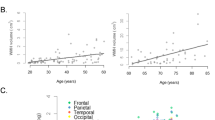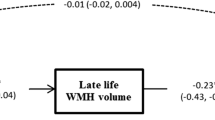Abstract
Vascular aging consists of complex and multifaceted processes that may be influenced by genetic polymorphisms of the renin-angiotensin system. A polymorphism in the angiotensin II type 1 receptor gene (AGTR1/rs5186) has been associated with an increased risk for arterial stiffness, hypertension, and ischemic stroke. Despite these identified relationships, the impact of AGTR1 A1166C on white matter integrity and cognition is less clear in a healthy aging population. The present study utilized indices of neuroimaging and neuropsychological assessment to examine the impact of the A1166C polymorphism on subcortical hyperintensities (SH) and cognition in 49 healthy adults between ages 51–85. Using a dominant statistical model (CC + CA (risk) vs. AA), results revealed significantly larger SH volume for individuals with the C1166 variant (p < 0.05, partial eta2 = 0.117) compared with those with the AA genotype. Post hoc analyses indicated that increased SH volume in C allele carriers could not be explained by vascular factors such as pulse pressure or body mass index. In addition, cognitive performance did not differ significantly between groups and was not significantly associated with SH in this cohort. Results suggest that presence of the C1166 variant may serve as a biomarker of risk for suboptimal brain integrity in otherwise healthy older adults prior to changes in cognition.
Similar content being viewed by others
References
Ando H, Zhou J, Macova M, Imboden H, Saavedra JM (2004) Angiotensin II AT1 receptor blockade reverses pathological hypertrophy and inflammation in brain microvessels of spontaneously hypertensive rats. Stroke 35(7):1726–1731
Bigler ED, Neeley ES, Miller MJ, Tate DF, Rice SA, Cleavinger H et al (2004) Cerebral volume loss, cognitive deficit and neuropsychological performance: comparative measures of brain atrophy: I. Dementia. J Int Neuropsychol Soc 10(03):442–452
Ceolotto G, Papparella I, Bortoluzzi A, Strapazzon G, Ragazzo F, Bratti P et al (2010) Interplay between miR-155, AT1R A1166C polymorphism, and AT1R expression in young untreated hypertensives. Am J Hypertens 24(2):241–246
Cook IA, Leuchter AF, Morgan ML, Dunkin JJ, Witte E, David S et al (2004) Longitudinal progression of subclinical structural brain disease in normal aging. Am J Geriatr Psychiatr 12(2):190–200
Diz DI, Arnold AC, Nautiyal M, Isa K, Shaltout HA, Tallant E (2011) Angiotensin peptides and central autonomic regulation. Curr Opin Pharmacol 11(2):131–137
Duff K, Patton D, Schoenberg MR, Mold J, Scott JG, Adams RL (2003) Age-and education-corrected independent normative data for the RBANS in a community dwelling elderly sample. Clin Neuropsychol 17(3):351–366
Duff K, Langbehn DR, Schoenberg MR, Moser DJ, Baade LE, Mold J et al (2006) Examining the repeatable battery for the assessment of neuropsychological status: factor analytic studies in an elderly sample. Am J Geriatr Psych 14(11):976–979
Duncan JA, Scholey JW, Miller JA (2001) Angiotensin II type 1 receptor gene polymorphisms in humans: physiology and pathophysiology of the genotypes. Curr Opin Nephrol Hypertens 10(1):111–116
Ebrahimi AP (2009) Mechanical properties of normal and diseased cerebrovascular system. J Vasc Int Neurol 2(2):155
Gontkovsky ST, Beatty WW, Mold JW (2004) Repeatable battery for the assessment of neuropsychological status in a normal, geriatric sample. Clin Gerontol 27(3):79–86
Gorelick PB, Scuteri A, Black SE, DeCarli C, Greenberg SM, Iadecola C et al (2011) Vascular contributions to cognitive impairment and dementia a statement for healthcare professionals from the American Heart Association/American Stroke Association. Stroke 42(9):2672–2713
Gunning-Dixon FM, Raz N (2000) The cognitive correlates of white matter abnormalities in normal aging: a quantitative review. Neuropsychol 14(2):224
Haas U, Sczakiel G, Laufer SD (2012) MicroRNA-mediated regulation of gene expression is affected by disease-associated SNPs within the 3′-UTR via altered RNA structure. RNA Biol 9(6):924–937
Hajnal JV, Bryant DJ, Kasuboski L, Pattany PM, De Coene B, Lewis PD et al (1992) Use of fluid attenuated inversion recovery (FLAIR) pulse sequences in MRI of the brain. J Comp Assist Tomogr 16(6):841–844
Haley AP, Forman DE, Poppas A, Hoth KF, Gunstad J, Jefferson AL et al (2007) Carotid artery intima-media thickness and cognition in cardiovascular disease. Int J Cardiol 121(2):148–154
Jefferson AL, Tate DF, Poppas A, Brickman AM, Paul RH, Gunstad J, Cohen RA (2007) Lower cardiac output is associated with greater white matter hyperintensities in older adults with cardiovascular disease. J Am Geriatr Soc 55(7):1044–1048
Kramer JH, Mungas D, Reed BR, Wetzel ME, Burnett MM, Miller BL et al (2007) Longitudinal MRI and cognitive change in healthy elderly. Neuropsychol 21(4):412
Kuo HK, Chen CY, Liu HM, Yen CJ, Chang KJ, Chang CC et al (2010) Metabolic risks, white matter hyperintensities, and arterial stiffness in high-functioning healthy adults. Int J Cardiol 143(2):184–191
Lakatta EG (2002) Age-associated cardiovascular changes in health: impact on cardiovascular disease in older persons. Heart Fail Rev 7(1):29–49
Lane EM, Paul RH, Moser DJ, Fletcher TD, Cohen RA (2011) Influence of education on subcortical hyperintensities and global cognitive status in vascular dementia. J Int Neuropsychol Soc 17(03):531–536
Laurent S, Cockcroft J, Van Bortel L, Boutouyrie P, Giannattasio C, Hayoz D et al (2006) Expert consensus document on arterial stiffness: methodological issues and clinical applications. Eur Heart J 27(21):2588–2605
Lawton MP, Brody EM (1969) Assessment of older people: self-maintaining and instrumental activities of daily living. Gerontol 9(3):179–186
McKinley MJ, Albiston AL, Allen AM, Mathai ML, May CN, McAllen RM et al (2003) The brain renin–angiotensin system: Location and physiological roles. Int J Biochem Cell Biol 35(6):901–918
Natale F, Tedesco MA, Mocerino R, de Simone V, Di Marco GM, Aronne L et al (2009) Visceral adiposity and arterial stiffness: Echocardiographic epicardial fat thickness reflects, better than waist circumference, carotid arterial stiffness in a large population of hypertensives. Eur J Echocardio 10(4):549–555
Nation DA, Wierenga CE, Delano-Wood L, Jak AJ, Delis DC, Salmon DP, Bondi MW (2010) Elevated pulse pressure is associated with age-related decline in language ability. J Int Neuropsychol Soc 16(5):933
Nilsson PM, Lurbe E, Laurent S (2008) The early life origins of vascular ageing and cardiovascular risk: The EVA syndrome. J Hypertens 26(6):1049–1057
Nishimura H (2001) Angiotensin receptors—evolutionary overview and perspectives. Comp Biochem Physiol, Part A: Mol Integr Physiol 128(1):11–30
Opherk C, Gonik M, Duering M, Malik R, Jouvent E, Hervé D et al (2014) Genome-wide genotyping demonstrates a polygenic risk score associated with white matter hyperintensity volume in CADASIL. Stroke 45(4):968–972
Pacholczyk M, Ferenc T, Kowalski J, Adamczyk P, Chojnowski J, Ponikowska I (2013) Association of angiotensin-converting enzyme and angiotensin II type I receptor gene polymorphisms with extreme obesity in polish individuals. DNA and Cell Biology
Paul RH, Haque O, Gunstad J, Tate DF, Grieve SM, Hoth K et al (2005) Subcortical hyperintensities impact cognitive function among a select subset of healthy elderly. Arch Clin Neuropsychol 20(6):697–704
Paul R, Lane EM, Tate DF, Heaps J, Romo DM, Akbudak E et al (2011) Neuroimaging signatures and cognitive correlates of the Montreal cognitive assessment screen in a nonclinical elderly sample. Arch Clin Neuropsychol 26(5):454–460
Putzke JD, Williams MA, Rayburn BK, Kirklin JK, Boll TJ (1998) The relationship between cardiac function and neuropsychological status among heart transplant candidates. J Cardiac Fail 4(4):295–303
Randolph C (1998) RBANS manual: repeatable battery for the assessment of neuropsychological status. The Psychological Corporation, San Antonio, TX
Saavedra JM (2005) Brain angiotensin II: new developments, unanswered questions and therapeutic opportunities. Cell Mol Neurobiol 25(3–4):485–512
Saavedra JM, Benicky J, Zhou J (2006) Mechanisms of the anti-ischemic effect of angiotensin II AT 1 receptor antagonists in the brain. Cell Mol Neurobiol 26(7–8):1097–1109
Saavedra JM, Sánchez-Lemus E, Benicky J (2011) Blockade of brain angiotensin II AT1 receptors ameliorates stress, anxiety, brain inflammation and ischemia: therapeutic implications. Psychoneuroendocrinol 36(1):1–18
Safar ME, Blacher J, Mourad JJ, London GM (2000) Stiffness of carotid artery wall material and blood pressure in humans: application to antihypertensive therapy and stroke prevention. Stroke 31(3):782–790
Sanfilipo MP, Benedict RH, Zivadinov R, Bakshi R (2004) Correction for intracranial volume in analysis of whole brain atrophy in multiple sclerosis: the proportion vs. residual method. Neuroimage 22(4):1732–1743
Saxby BK, Harrington F, McKeith IG, Wesnes K, Ford GA (2003) Effects of hypertension on attention, memory, and executive function in older adults. Health Psychol 22(6):587
Schmidt R, Schmidt H, Haybaeck J, Loitfelder M, Weis S, Cavalieri M et al (2011) Heterogeneity in age-related white matter changes. Acta Neuropatholog 122(2):171–185
Sethupathy P, Borel C, Gagnebin M, Grant GR, Deutsch S, Elton TS et al (2007) Human microRNA-155 on chromosome 21 differentially interacts with its polymorphic target in the <i> AGTR1</i> 3′ untranslated region: a mechanism for functional single-nucleotide polymorphisms related to phenotypes. Am J Hum Genet 81(2):405–413
Sierra C, Coca A, Schiffrin EL (2011) Vascular mechanisms in the pathogenesis of stroke. Cur Hypertens Rep 13(3):200–207
Söderlund H, Nyberg L, Adolfsson R, Nilsson LG, Launer LJ (2003) High prevalence of white matter hyperintensities in normal aging: relation to blood pressure and cognition. Cortex 39(4):1093–1105
Strazzullo P, D'Elia L, Cairella G, Garbagnati F, Cappuccio FP, Scalfi L (2010) Excess body weight and incidence of stroke meta-analysis of prospective studies with 2 million participants. Stroke 41(5):e418–e426
Tate DF, Khedraki R, Neeley ES, Ryser DK, Bigler ED (2011) Cerebral volume loss, cognitive deficit, and neuropsychological performance: comparative measures of brain atrophy: II. Traumatic brain injury. J Int Neuropsychol Soc 17(02):308–316
Taylor WD, Steffens DC, Ashley-Koch A, Payne ME, MacFall JR, Potocky CF, Krishnan KRR (2009) Angiotensin receptor gene polymorphisms and 2-year change in hyperintense lesion volume in men. Mol Psychiatr 15(8):816–822
Taylor WD, Zhao Z, Ashley Koch A, Payne ME, Steffens DC, Krishnan RR, MacFall JR (2013) Fiber tract specific white matter lesion severity: findings in late life depression and by AGTR1 A1166C genotype. Hum Brain Map 34(2):295–303
Tchkonia T, Morbeck DE, Von Zglinicki T, Van Deursen J, Lustgarten J, Scrable H et al (2010) Fat tissue, aging, and cellular senescence. Aging Cell 9(5):667–684
Thalmann S, Meier CA (2007) Local adipose tissue depots as cardiovascular risk factors. Cardiovasc Res 75(4):690–701
Verstynen TD, Weinstein AM, Schneider WW, Jakicic JM, Rofey DL, Erickson KI (2012) Increased body mass index is associated with a global and distributed decrease in white matter microstructural integrity. Psychosomat Med 74(7):682–690
Zieman SJ, Melenovsky V, Kass DA (2005) Mechanisms, pathophysiology, and therapy of arterial stiffness. Arterioscler, Thromb, Vasc Biol 25(5):932–943
Acknowledgments
This study was financially supported by National Institutes of Health (NIH)/National Institute of Neurological Disorders and Stroke (NINDS) grants R01 NS052470 and R01 NS039538, NIH/National Institute of Mental Health (NIMH) grant R21 MH090494, and Australian National Health and Medical Research Council (NHMRC) grant 1037196. DNA extractions were performed by Genetic Repositories Australia, an Enabling Facility, which is supported by NHMRC grant (401184). Recruitment database searches were supported in part by NIH/National Center for Research Resources (NCRR) grant UL1 TR000448.
Conflict of interest
There are no actual or potential conflicts of interest for any of the authors on this manuscript.
Author information
Authors and Affiliations
Corresponding author
About this article
Cite this article
Salminen, L.E., Schofield, P.R., Pierce, K.D. et al. Impact of the AGTR1 A1166C polymorphism on subcortical hyperintensities and cognition in healthy older adults. AGE 36, 9664 (2014). https://doi.org/10.1007/s11357-014-9664-x
Received:
Accepted:
Published:
DOI: https://doi.org/10.1007/s11357-014-9664-x




